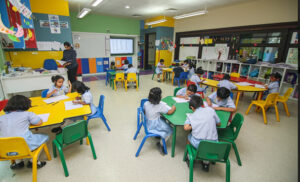Positive reinforcement in a School in Abu Dhabi stimulates the will of a specific act and increases the chances of repeating the same behavior in a student, class instructor, teacher, or management. The basic theory explains that an act or behavior will fall into a repetition loop if triggered by an immediate reinforcement application.
One thing we have to keep in mind is that positive reinforcement is totally against bribing. Bribing is something different, which points to opposing sides. It even brings additional acts of struggle in the classroom.
What is Positive Reinforcement in Teaching?
B. F. Skinner explained the appropriate definition of the conceptualization of positive reinforcement. He studied that positive reinforcement in the teaching profession reflects an overarching purpose, which offers a stimulus to students to make them perform the same desired acts or behaviors in the future.
So when they achieve something influenced by positive reinforcement from the teacher, they get the motivation to do those things again in the future.
Also, teaching staff must ensure that teachers should fix reinforcement programs according to the ages of students. Even they should place genuine actions, like; as rewarding students for performing desired behaviors.
Types of Positive Reinforcement
Positive reinforcement in the classroom consists of four distinct types, which are encouraging and influencing.
Types of Positive Reinforcement are:
Natural Reinforcers
This type is straightforward and results directly from repeated behavior. For example, a man gets rewarded and appreciated with a promotion for his constant devotion to his research work and for bestowing efforts to organize campaigns.
Social Reinforcers
It reflects an expressing appraisal for the occurrence of the desired praise of a child for his excellent effort in study, or an employer can appreciate employees in front of everybody for their achievements in the workplace.
Tangible Reinforcers
This expresses physical rewards towards an expected behavior or action. This reward includes many influencing things; toys, chocolates, treats, candies, money, and other things.
Token Reinforcers
Occurring of a particular action is awarded as points or tokens. That performing person can exchange those accumulated points in value. For example, a teacher rewards students with a prize when they complete their projects in a given deadline.
What are the Examples of Positive Reinforcement in the Classroom?
Positive reinforcement helps students in their Journey from Primary School to High School to be disciplined, motivated, and obedient towards their institutions and teachers. Here are examples of positive reinforcement in the classroom:
Example Of Positive Reinforcement
● The more students complete their given assignments and projects on time, the more they will get points in place of appreciation. School management will then convert the total accumulated points into a prize that teachers will give those who have achieved desired excellence individually.
● Students who take the initiative to keep playgrounds clean on winter afternoons will be treated with cookies, chocolates, or cocoa cakes.
● Librarian will praise those who stay silent in the library room.
● Teachers will give more extra offs if the whole class will pass in the exams.
● Teachers try to keep students motivated by different actions instead of punishing them for their grave mistakes.
● Teachers also use physical reinforcers to praise students for their progress. These reinforcers include money, candies, chocolates, another type of treats, toys, and so many other things.
● Teachers appreciate students by clapping in front of others in the classroom. Teachers sometimes organize a pizza party for the whole class for their holistic performance.
Importance of Positive Reinforcement in Teaching
When teachers imply positive reinforcement in teaching to receive something good from students, the purpose does not mean to fetter punishments. This reinforcement encourages and influences students toward a specific desirable behavior or action to do repetitively. So, this positive way leads them to tremendous success in their future.
In addition, providing examples of positive reinforcement in the classroom to encourage desirable actions with an appropriate direction helps teachers plan systematically and avoid haphazardly scheduled inappropriate actions. It also reduces the mistakes in promoting unplanned things. Needless to say, the importance of the Positive Reinforcement process is quite challenging to execute; paying attention in the right direction will give the most favorable outcome.
How Positive Reinforcement Works?
Positive reinforcement in the classroom is a straightforward technique that is fruitful entirely to reality. It will turn all students’ behavior in the right way. Here are some Positive Reinforcement Activities that an institution can take to make its program effective and fruitful.
Reinforcement Strategies in the Classroom
1. Students want teachers’ appreciation badly.
2. Teachers’ observation of desirable positive actions done by students brings natural praise with natural rewards.
3. Students feel overwhelmed, happy, and validated if their teachers notice their positive changes by repetition of certain positive behaviors or actions in a continuous process.
4. Teachers also need to focus bout what students are doing right, but not to focus about what they have done wrong. Teachers adopting this technique will increase every student’s positive side, enthusiasm, and courage. Also, they will become more motivated to do those right things again and again.
5. Even students begin to identify positive qualities and behaviors towards their actions.
Positive Reinforcement Activities in the classroom
1. Be Clear and Consistent
Teachers give a clear idea about the positive reinforcement programs to get a consistent outcome from students.
2. Reinforcement Should Be Instant
If a teacher wants to change or focus on someone’s behavior in the class, the immediate implementation of positive reinforcement will work best.
3. Never Take Reward Back
If you are treating a student with harsh gestures for their failure, you must remember their previous success and achievements. This type of behavior will badly harm a student mentally.
4. Choose Carefully The Right Thing For All Students
Teachers must precisely select things that every child can enjoy equally in their classroom.
5. Make Sure it’s Attainable
Many from the teaching profession do not know the proper use of positive reinforcements for students in the classrooms. It is an excellent suggestion for those to limit their students’ expectations and make the demands attainable and realistic.
6. Teachers Should Reward Every Student individually
Teachers must treat students equally. It is a wrong approach teachers show by rewarding one particular student repeatedly. So, this destroys others’ minds, and they find no point in making the same happen to them. So, a teacher should go deep and call everyone for their utmost dedication and achievements.
Don’t Miss: English Teaching Methods for Primary Classes
Use of Positive Reinforcement in Early Childhood Education
Schools should enlist behavior management in every child’s education in their childhood. They should know how to behave right from the early stages of life. You might notice that parents used to yell at their children’s specific misbehavior constantly.
Also, parents often lose their patience in giving lessons about the right things. But in reality, these approaches harm their children’s mental stability and willingness to rectify the mistakes they are making repeatedly. Eventually, it is crucial to guide them with proper gestures from childhood.
Positive reinforcement is the right way, which engrains discipline, obedience, and motivation to do certain desirable things. Even this process is totally out of any hostile gesture, like; threat, punishment, mental harassment, and humiliation. Besides this, positive reinforcement sets some correctional measures with good aspects and approaches. As a result, teachers and parents both begin to receive better responses from children.
A List of Positive Reinforcement Words and Phrases to Use
There is a comprehensive collection of words and phrases that express the implications of positive reinforcement.
Positive Reinforcement Words and Positive Reinforcement Phrases:
Words
● Be Generous
● Positivity
● Be intelligent
● Rewarding stimuli
● Affirmative
● Feel important
● Love each other
● Good thing
● Save environment
Phrases
● Remarkable
● You’re a Winner
● That’s Incredible
● How Thoughtful of You
● It Couldn’t Be Better
● You’re a Great Example For Others
● Keep Up the Good Work
● Amazing Effort!
● Unbelievable Work
● You’re a Champ
Benefits of Positive Reinforcement in Teaching
Benefits of Positive Reinforcement are:
Provides Long Term Benefits
Positive reinforcement influences students to perform certain tasks repetitively. So it leaves a long-term impact on a child’s mind.
Develops a Child’s Character
This process helps students or children build up and develop their character with good terms. It functions in a positive way to light up the insights of a child. Even it makes every student disciplined, obedient, and honest in their work.
It makes Children Feel Loved
Constant attention and observation of teachers and parents at their excellent efforts, achievements, and correct things, make children happy, satisfied, loved, and validated.
Improves A Student’s Self-Esteem
This positive reinforcement program helps a student or child achieve better results. They start to feel good about themselves.
Even this process makes them believe that they are innately good and can do better work in their life.
What is Negative Reinforcement?
Negative reinforcement is a stimulus that prevents students from doing harmful or undesirable behavior or actions.
Examples of Negative Reinforcement in the Classroom:
● Making a student free from weekend homework due to their sound behavior in the class
● Giving freedom not to attend extra classes if they score well in the exams.
● Breaking the silent atmosphere in the class when all students have completed the given tasks.
● Making students give more input to get good grades in exams.
● Allowing students to escape early morning sessions if they performed well in previous matches.
● Punishing or humiliating students for their mistakes or repetitive failures
Positive Reinforcement vs Negative Reinforcement
1. Positive reinforcement implies stimuli to develop chances of repetitive occurrence of specific actions or behaviors. In Negative reinforcement, stimuli get removed to achieve some good behaviors.
2. In positive reinforcement, stimuli execute some pleasant upshots, but in a hostile program, stimuli reflect some unpleasant outcomes.
3. Positive reinforcement rewards students for their excellent work and sets good examples for those not doing well in the classroom. In negative reinforcement, students get punished and misbehave for their failures.
4. In a positive program, teachers keep responding and maintain well-communication with students. In negative reinforcement, teachers stop responding and avoid those lacking in performance.
Conclusion
Here, we have discussed the positive and negative reinforcement examples.
Positive reinforcement induces pleasant reinforcers to trigger willingness in students to perform desired tasks constantly. But, negative reinforcement programs act the opposite. It removes unfavorable reinforcers to get desired results and better responses from students.





























